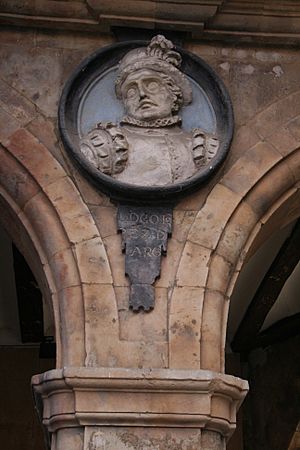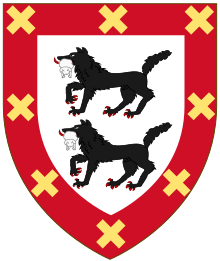Diego López II de Haro facts for kids
Quick facts for kids
Diego López II de Haro
|
|
|---|---|
 |
|
| Lord of Biscay | |
| Reign | 1170–1214 |
| Predecessor | Lope Díaz I de Haro |
| Successor | Lope Díaz II de Haro |
| Born | c. 1152 |
| Died | 16 September 1214 |
| Buried | Santa María la Real of Nájera |
| Noble family | Haro |
| Spouse(s) | María Manrique de Lara Toda Pérez de Azagra |
| Issue among others... |
Lope Díaz II de Haro |
| Father | Lope Díaz I de Haro |
| Mother | Aldonza Rodríguez |
Diego López II de Haro (born around 1152 – died September 16, 1214) was a very important noble in the Kingdom of Castile. People called him the Good or the Bad. He was the son of Lope Díaz I de Haro and Countess Aldonza.
Diego López II was a powerful leader during the time of King Alfonso VIII (1158–1214). He helped his family, the Haro dynasty, become very strong. They were so important that they played a big role in Castilian politics for the entire 13th century. Later, people told different stories about him, some good and some bad, which led to his two nicknames.
Contents
Diego López II and King Alfonso VIII
Diego López II didn't always stay at the royal court. Sometimes, other powerful families, like the Lara family, had more influence.
Between 1179 and 1183, he left Castile and went to the Kingdom of Navarra. When he came back, he was in a strong position. He became the alférez, which was like the king's main standard-bearer. This was one of the most important jobs in the kingdom.
In 1187, he left Castile again. His sister, Urraca López, married King Fernando II of León, and Diego hoped for better opportunities there. But King Fernando II died the next year, so Diego came back to Castile. He was still respected and got his important job back.
In 1195, he fought in the Battle of Alarcos against the Almohads, who were Muslim rulers from North Africa. The Castilian army lost this battle, and Diego helped defend the land afterward.
Later, King Alfonso VIII sometimes removed Diego from his important job, giving it to another noble, Álvaro Núñez de Lara. Diego even went into exile a third time, from 1201 to 1206, offering his help to Navarra and León.
However, Diego López II was so important that King Alfonso VIII needed him. In 1206, the king even admitted he had treated Diego unfairly. When Diego returned to Castile, the king trusted him completely again.
In 1212, Diego López II led one of the three armies in the famous Battle of Las Navas de Tolosa. This battle was a huge victory for the Christian kingdoms against the Almohads. It greatly weakened the Almohads' power in al-Andalus (southern Spain).
Some people believed that King Alfonso VIII wanted Diego López II to be the regent (a temporary ruler) for his young son, Henry I. But Diego López II died a few weeks before King Alfonso VIII.
Lands and Power
After his first time in exile (1179-1183), Diego López II got back the lands his father had ruled, like La Rioja and Old Castile. He also gained control of other areas, including Asturias and Bureba.
After his second exile, his power grew even more in northeastern Castile. By 1196, he ruled a large area "from Almazán to the sea."
In 1204, to convince him to return to Castile, King Alfonso VIII officially recognized Diego's ownership of all of Bizcaya (Biscay). This Basque territory had been ruled by his family in the past. This was a very important step because it meant Biscay became a permanent family possession, forming the main land base for the Haro family throughout the 13th century.
In 1212, after the Battle of Las Navas de Tolosa, the king also gave him Durando. Diego also started sharing some of these lands with his oldest son, Lope Díaz II de Haro. For example, Lope received Old Castile in 1210, Asturias de Santillana in 1211, and Álava in 1213. This helped make sure the family's power would continue.
Building a Family Name
Diego López II made his family, the Haro clan, much stronger. He was the first in his family to regularly use a family name, or apellido, in official documents starting in 1184. This helped show that his family was a powerful dynasty, meaning their importance would pass down from parents to children.
Stories and Legends

Over time, people told many different stories about Diego López II. His reputation changed depending on who was telling the story and what their goals were.
Soon after his death, in 1216, some people at the royal court said he was a "bad lord." Later, around 1240, a writer named Rodrigo Jiménez de Rada wrote about him. Rodrigo had known Diego personally, but his description was still a bit unclear. He criticized Diego for sometimes leaving Castile and even fighting against his own king.
The tombs of Diego López II and his wife, Toda Pérez, are in the abbey of Santa María de Nájera. These tombs were made later in the 13th century and show how important Diego was to his family as a founder.
In the 1270s and 1280s, when Diego's grandson, Lope Díaz III, was rebelling against King Alfonso X, writers who supported the king tried to make Diego López II look bad. They even blamed him for the defeat at Alarcos, saying he was "the Good" but actually caused problems.
But writers who supported the Haro family created their own stories. For example, the story of the Jewish girl from Toledo appeared around the end of the 13th century. This story tried to explain the defeat at Alarcos by blaming King Alfonso VIII's sins instead of Diego López II.
By the 1340s, books by a Portuguese count named Pedro de Barcelos mixed real events with popular stories. He made Diego López II an "ambiguous character," meaning he had both good and bad traits, trying to combine all the different legends about him.
In the mid-15th century, another writer, Lope García de Salázar, finally came up with the nickname "the Bad" to explain all the confusing and different stories about Diego López II. His memory continued to change over the centuries, as different groups used his story to support their own ideas.
Marriage and Children
Diego López II de Haro married twice.
His first wife was Maria Manrique de Lara. They had one son:
- Lope Díaz II de Haro – who took over his father's title as Lord of Biscay.
His second wife was Toda Pérez de Azagra. They had several children:
- Pedro Díaz – who became lord of Cárcar.
- Urraca Díaz – who married Count Álvaro Núñez de Lara (died 1218).
- Aldonza Díaz – who married Ruy Díaz de los Cameros.
- María Díaz – who married Count Gonzalo Núñez de Lara.
- Teresa Díaz de Haro – who married her cousin, Infant Sancho of León.
- Mencía Díaz – who married Alvaro Díaz de los Cameros.
|
Diego López II de Haro
Born: circa 1152 Died: 16 September 1214 |
||
| Regnal titles | ||
|---|---|---|
| Preceded by Lope Díaz I de Haro |
Lord of Biscay 1170–1214 |
Succeeded by Lope Díaz II de Haro |
See also
 In Spanish: Diego López II de Haro para niños
In Spanish: Diego López II de Haro para niños

